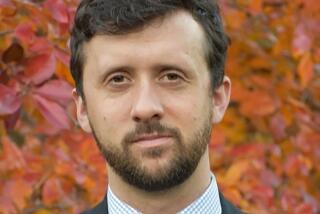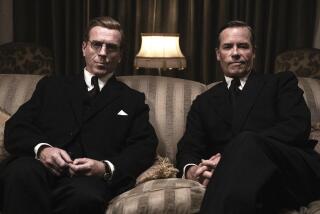Neither U.S. Spy Nor KGB Foe Could Turn the Other
MOSCOW â A spy is a fabulist, a spinner of false tales, a maker of unreal worlds. A spy is a seducer of reckless hearts and broken souls, and a voyeur of the carnage left behind.
A spy is not true.
But Gennadiy Vasilenko and Jack Platt never lived strictly by the rules of their profession.
Platt, of the CIA, and Vasilenko, of the KGB, were assigned to corrupt each other. Instead, they reached across the minefield of Cold War espionage to forge an extraordinary friendship.
For years, they tried to maintain their brotherhood in the wilderness of mirrors that was the game between the CIA and KGB. Ultimately their relationship fell victim to a coldblooded act by another spy, one devoid of loyalties: Aldrich H. Ames.
In this previously untold tale of betrayal and post-Cold War redemption, Gennadiy Vasilenko emerges as an uncounted victim of the CIAâs most damaging spy case in its 50 years. Once Ames exposed Vasilenko to the harsh judgment of the lords of the KGB, his friendship with Platt very nearly cost him his life.
Yet through it all their friendship remained constant. And, in a stranger-than-fiction ending that teaches much about the march of capitalism, they are now pooling their CIA-KGB spy talents in a bid to get rich on the Wild West business scene of post-communist Russia.
If it hadnât been for an early shoulder injury, the tall, lean and hawk-nosed Vasilenko might have gone on to glory as a Soviet volleyball star rather than into a hidden life as a KGB spy. When injuries ended his hopes of making the Soviet national volleyball squad heading for the 1964 Tokyo Olympics, he found himself steered instead into a slot in the KGBâs training program.
Vasilenko eventually joined the KGBâs elite First Directorate, which handled foreign intelligence, and in 1976 was assigned to âLine KR,â counterintelligence, in the KGBâs premier overseas station, Washington.
He enjoyed at least one major success, serving as the KGBâs first case officer for former National Security Agency employee Ronald Pelton, one of Moscowâs most important spies inside the United States.
After Pelton walked into the Soviet Embassy in Washington in January 1980 to volunteer to work for the KGB, Vasilenko dressed him up in a disguise and put him on a bus crowded with Russian embassy employees to sneak him out without being detected by the FBI.
Pelton ultimately exposed the so-called Ivy Bells project, in which the Navy and NSA had installed eavesdropping equipment on an underwater Soviet military communications cable off the Siberian coast.
Pair Get Acquainted on Similar Missions
Vasilenkoâs days in Washington also brought him into contact with his opposite number on the American side, Jack Platt, a rumpled and gruff former Marine who had joined the CIA in 1963 and who by the late 1970s was a hardened veteran of the CIAâs Soviet Division. They became acquainted while trying to lure one another into committing treason.
Based in Washington, Platt was trolling for KGB officers in 1977 when a Soviet defector, a former classmate of Vasilenkoâs at the KGBâs training institute, identified Vasilenko as one of the KGB officers working under diplomatic cover in the Soviet Embassy.
Platt took the first step, arranging through an intermediary to bump into Vasilenko at a Harlem Globetrotters basketball game in Washington.
Almost immediately, Platt found that despite his secret mission to recruit Vasilenko, he was being charmed by the Russian. âHalfway through the game I realized, I really like this guy,â he recalled in an interview.
Platt persisted, even though Vasilenko showed no interest in the Americanâs blandishments.
âI never stopped trying to recruit him,â sighed Platt. âBut he never crossed the line.â The best evidence: Vasilenko never told Platt about Pelton, who wasnât caught until he was compromised by a Soviet defector, KGB officer Vitaly Yurchenko, in 1985.
Instead, Vasilenko tried to turn the tables, asking Platt to work for the KGB, with dismal results. Platt recalls telling Vasilenko: âWhat in the hell can you offer me?â
Through their awkward espionage courtship, Platt and Vasilenko gradually discovered they were soul mates--streetwise risk-takers who shared a voracious love for the spy game and a disdain for the faceless bureaucrats back at headquarters.
Before long, they were meeting quietly at cafes around Washington for dinner and drinks; finally, they worked up the nerve to go off hunting and shooting together in the West Virginia forests. By the end of Vasilenkoâs tour in Washington, Platt had helped Vasilenko buy a new car and was even going home with Vasilenko for dinner with his wife and two children.
The friendship grew so strong, Vasilenko recalled in an interview, that they finally called a truce. âWe told each other, donât try, letâs be friends, letâs have a good relationship, forget about the task. That was the agreement. It was good times, thatâs why we continued.â
But Vasilenko was on the wrong side of history, and that harsh truth kept intruding. While he gave up trying to recruit Platt to the slowly crumbling Soviet system, Platt continued working on his friend. For years, in fact, Platt continued to use his CIA alias--Chris was his âwork nameâ--in his meetings with Vasilenko.
Vasilenko never gave in to temptation. But he stopped filing official reports about their contacts. He kept up the relationship after his KGB supervisors, increasingly suspicious about Vasilenkoâs ties to Platt, told him to break it off, and even after his wife warned angrily that his indiscretions would lead to ruin.
Yet the element of risk only seemed to energize Vasilenko. He understood that CIA regulations required Platt to continue to report on their meetings, but he assumed that was just American bureaucratic nonsense and would never interfere with their friendship--an assumption that nearly brought Vasilenkoâs life to a premature end.
Platt, realizing how dangerous it would be for Vasilenko to meet him inside the Soviet Union, broke off contact when the Soviet spy was given a routine transfer back to Moscow in 1981.
âI told him to go have a good tour and enjoy the wonderful quality of life in Moscow, and experience the socialist paradise again,â Platt said. âI told him that when he came back out [for a new overseas posting] I would find him.â
Vasilenko Assigned to S. America Backwater
When Vasilenko came back out in 1984, it was for an assignment that might have walked right off the pages of Graham Greeneâs âOur Man in Havana.â
The Soviet ambassador to the tiny South American backwater of Guyana happened to have excellent political connections, and he apparently complained to Moscow that he needed a fully staffed KGB station in his embassy--an important measure of status within the Soviet foreign affairs bureaucracy. Before Vasilenko knew what had hit him, he found himself on an airplane bound for Georgetown, Guyana, as the KGB deputy rezident, or deputy station chief.
Vasilenko quickly became bored to death in Georgetown, where there were only limited opportunities to spy on the KGBâs main enemy, the CIA. Only the occasional visits from Platt broke the subtropical monotony.
Platt had been watching patiently for signs of Vasilenkoâs reemergence from the Soviet Union, and as soon as he discovered that he was in Guyana, Platt received approval from CIA management to fly down to Georgetown and resume his efforts to recruit his old companion.
They easily renewed their friendship, but now, there was a sharper edge of tension. Vasilenko, who had been clearly forbidden from seeing Platt, found it more difficult to put aside the Cold War pressures and simply enjoy his friendâs company.
âIn Georgetown, I met [Platt] unofficially,â Vasilenko acknowledged. âAt first, I sent a telegram to Moscow, saying my old [CIA] contact is here, and I asked for permission to meet him. Permission was not granted, and I got [angry]. In Georgetown, Guyana, what else is there to do? The main task was to work against Americans, but how could I work against Americans without meeting them?â
Platt was stubbornly still intent on trying to recruit Vasilenko, but Vasilenko was just as obstinate in his repeated deflections of Plattâs offers.
Back in Moscow, meanwhile, the KGB was trying to cope with Ames, who had revealed just how thoroughly the Americans had penetrated the KGB. Each day seemed to bring a new scandal as one KGB officer after another was arrested for spying, interrogated and shot. In 1985 and 1986, as many as 10 Russian spies working for the CIA were executed.
Morale plunged inside the First Directorate as a result. Because the KGB had kept Amesâ treachery secret from all but a few of its top officials, almost no one knew what had prompted all the arrests.
âWhenever you walked down the halls, you felt like hiding your face,â recalled Vasilenko. âYou never knew who might be a mole.â
During his long talks in Guyana with Platt, Vasilenko would sometimes grumble about KGB office politics, and Platt would humor his friend by complaining about his own bosses in the CIAâs Soviet Division. In the process, Vasilenko would occasionally, and perhaps inadvertently, pass on tidbits about what had happened in 1985 and 1986 that Platt and the CIA found useful.
At one point, Ames, then still a colleague of Plattâs in the Soviet Division, approached him to discuss the explosive and puzzling case of Vitaly Yurchenko, who had defected to the CIA in August 1985, and then redefected to the Soviets in November 1985.
Unaware that Ames was on the KGBâs payroll, Platt confided to him that âI might have a way to find out what happened to Yurchenko after he returned to Moscow.â
But Platt stubbornly refused suggestions from second-guessers at headquarters that he had enough leverage over Vasilenko to blackmail him into becoming an American spy. Blackmail makes for resentful agents, Platt countered. He would take Vasilenko only if he volunteered.
Platt Retires, but He Stays On as Contractor
Platt retired from the CIA in 1987 but was kept on as a CIA contractor into 1988, specifically to keep trying to lure Vasilenko into espionage. Platt told himself that by continuing to try to recruit his friend, he was actually doing Vasilenko a favor.
âI knew how rotten that [Soviet] system was, and I knew that he didnât fit into it,â he said. âI knew that if he came to the U.S., he could be a great volleyball coach, or have some other wonderful career.â
Platt last visited Guyana in the fall of 1987, promising Vasilenko that he would return the following February to celebrate his birthday with his friend.
But when it came time for Platt to arrange his trip, he found to his horror that Vasilenko had vanished without a trace. âThere was dead silence, the kind of silence that we had heard when our agents all were arrested in 1985. I was sick to my stomach.â
In fact, Vasilenko was already one month into his nightmare journey into the dark belly of the KGB.
In January 1988, Vasilenko flew to Cuba from Guyana on routine KGB business, with plans to stay with an old KGB friend. He was met instead by the KGBâs local security officer, who told him that his friend had been suddenly called away. But the security officer had thoughtfully found Vasilenko another house to use during his stay.
As Vasilenko stepped inside, KGB security men threw him to the floor and split his head open. He was in a KGB safe house, under arrest for espionage.
As the interrogations began, it soon became clear why. âThey asked me if I knew Mr. Platt,â Vasilenko recalled.
Vasilenko was dumped onto a Russian freighter and given a one-way ticket to the KGBâs deepest hole. Aboard ship, âI was thinking, why not just jump off, kill myself. I knew nobody would help me when I got to Moscow. I knew people who had been shot. . . . But then I thought of my family.â
During his first grilling in the KGBâs Lubyanka Prison, Vasilenkoâs interrogators told him that Cuban intelligence agents had found an incriminating tape recording of his last meeting with Platt, who had carelessly left it behind in a hotel room. We know you are a spy, the interrogators insisted. Confess.
Vasilenko didnât believe them. On his way back to his cell, he remembered that Platt had promised never to record their meetings. In the depths of his despair, Vasilenko needed something on which to place his faith, and he settled on the truthfulness of his old friend. If Platt had told him there was no tape recorder, then the interrogators were lying. Vasilenko could withstand their worst.
Vasilenkoâs leap of faith saved his life. In fact, Platt had not taped their meetings; the KGB had fabricated the story of the Cuban discovery to hide the real source of their information--almost certainly Ames.
Ames had stolen a small mountain of CIA files, so many that he later said even he didnât know what was in all of them. Ames probably gave the KGB copies of Plattâs reports on his contacts with Vasilenko in Guyana.
Fortunately for Vasilenko, Platt had never exaggerated his relationship with the Soviet in his reports. The files showed only that Vasilenko had held unauthorized meetings with Platt.
Still, the KGB held Vasilenko for six months, rotating informants into his cell as bunkmates. Vasilenko never broke, and word finally filtered down that the KGB no longer believed he was a spy.
Finally released, Vasilenko was still cashiered from the KGB under charges that he had illegally imported hunting rifles into the Soviet Union. And there was one final insult: He was demoted from KGB lieutenant colonel to major just before he was fired.
Denied a KGB pension and forbidden to travel overseas, Vasilenko found it difficult to pick up the pieces of his life in Moscow.
Platt, meanwhile, wracked with guilt over the possibility that his actions had somehow led to Vasilenkoâs disappearance, tried for years to find out what had happened. âI thought he was dead.â
Angry and frustrated, Platt soon became convinced that a mole inside the CIA had fingered Vasilenko. Indeed, long before CIA management intensified the search that ultimately led to Ames, Platt, retired and on the outside, began to tell friends inside the CIAâs Soviet Division âto watch their backs.â
It wasnât until after the failed Soviet coup in August 1991 that Platt heard through a mutual acquaintance that Vasilenko was alive. Finally, he worked up the courage to telephone Vasilenko at his Moscow apartment.
When Vasilenko picked up the phone, Platt, using his old alias from his CIA days, quietly said, âHello, this is Chris.â
After what seemed to Platt to be an endless silence, Vasilenko genially replied: âHello Chris, Iâve been expecting your call.â
Recalled Platt: âI felt like crying.â
Two Ex-Spies Reunited When Vasilenko Visits
Their friendship, having survived the Cold War and the treachery of Ames, began anew. By 1992, Vasilenko was allowed to travel to the United States and, before long, he and Platt were in business together. Platt was determined to help the man who had lost his livelihood and nearly his life because of their friendship.
Vasilenkoâs Securitar, a private security and investigation service based in Moscow, and Plattâs Virginia-based international security consulting firm, Hamilton Trading Group, now work together on business security projects in Russia. Vasilenko, now 57, and Platt, 61, are once again free to go hunting together. Meanwhile, their families, including their children, have grown close.
Most important, Vasilenko has demonstrated to Platt the power of loyalty, and of forgiveness.
âHe has never asked me if I betrayed him,â says Platt. âAll he has ever said to me is, âI know it wasnât you.â â
(BEGIN TEXT OF INFOBOX / INFOGRAPHIC)
About This Series
Once it was the worldâs most mysterious and feared espionage organization, the âsword and shieldâ of the Soviet Union. But ultimately the KGB fell victim to the same forces of history that destroyed the empire it had served.
For the most part, the last KGB officers slipped away, retaining the cloak of secrecy. But now a group of former officers have stepped forward to provide an insiderâs guide. They agreed to a series of interviews with the Los Angeles Times, in part to put on the record what they see as their sacrifices and professionalism in a cause now widely denigrated.
* Monday: The spy who directed Aldrich H. Ames.
* Today: Two enemies, two friends.
* Wednesday: The Gavrilov channel, the KGB-CIA hotline.
* On the Web: The complete series will be accessible Wednesday on the Internet at http://ukobiw.net./kgb
More to Read
Sign up for Essential California
The most important California stories and recommendations in your inbox every morning.
You may occasionally receive promotional content from the Los Angeles Times.










